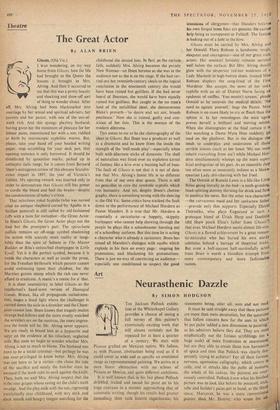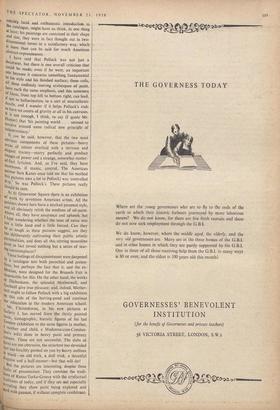Art
Neurasthenic Dazzle
By SIMON HODGSON It is well known that in his last phase Pollock dribbled, trailed and tossed his paint on to his huge canvases in a manner approaching that of automatic writing, though his results had greater immediacy than such bizarre experiments; his statements being, after all, seen and not read, It must be said straight away that these pictures are more than mere decoration, but the questions that follow concern how far the uses to which he put paint 'added a new dimension to painting, as his admirers believe they did. They are most emphatically not the furious scribblings (00 a huge scale) of mere frustration or resentment; but are they able to 'create those new harmonies of space and time that Pollock was clearly des- perately trying to achieve? For all their furious, nervous, egomaniac calligraphy, which covers in coils, and in streaks like the paths of meteors, the whole of his canvas, the pictures are enor- mously controlled. Pollock knew what his finished picture was to look like before he pounced, stick' tube and builder's paint-pot in hand, at the blank space. Moreover, he was a more conventional painter than Mr. Hunter, who wrote the ad" Mir.ably lucid and enthusiastic introduction, to the catalogue, might have us think, in one thing at least; his paintings are contained in their shape and size, they were in fact thought out in two- dimensional terms in a satisfactory way, which is more than can be said for much American abstract expressionism. I have said that Pollock was not just a decorator, but there is one overall criticism-that could be made, even if he were, an important one because it concerns something fundamental to his style and his finished surface; these coils, all these endlessly moving arabesques of paint, have each the same emphasis, and this sameness of focus, from top left to bottom right, can lead, if not to hallucination, to a sort of neurasthenic dazzle, and I wonder if it helps Pollock's ends to have no centre of gravity at all in his canvases. It is not enough, I think, to say (I quote Mr. Hunter) that 'his painting world . . . seemed to revolve around some radical new principle of indeterminacy.' It can be said, however, that the two most obvious components of these pictures—heavy areas of colour overlaid with a nervous and elegant tracery—marry perfectly and produce images of power and a strange, somewhat matter- °f-fact lyricism. And, as I've said, they have enormous, if manic, control. The American Painter Sam Kaner once told me that his method (his pictures owe a lot to Pollock) was 'controlled drip: So was Pollock's. These pictures really•should be seen.
At 41 Grosvenor Square there is an exhibition 01 work by seventeen American artists. All the Painters shown here have a marked personal style, and all obviously relish the medium of oil-paint. Above all, they have assurance and aplomb, but I kept wondering whethei: the tone of voice was not a little loud and a little forced. Can they he as tough as these pictures suggest, are they 1°0 deliberately cultivating their public artistic Personalities, and does all this stirring masculine Paint in fact reveal nothing but a series of sear- ing commonplaces? These feelings of disappointment were deepened by a catalogue text both parochial and preten- tious, but perhaps the fact that it, and the ex- hibition, were designed for the Brussels Fair is responsible for this. On the other hand, the works of Diebenkom, the splendid Motherwell, and Qechtott give true-pleasure; and, indeed, Mother- ought to follow Pollock with a big exhibition °n this side of the herring-pond and continue °ur education in the modern American school.
Mr. Christoforou, in his new pictures at Gallery I, has moved from the thinly painted static, iconographic, hieratic figures of his last London exhibition to the same figures (a mother, 4 mother and child, a Madonna-cum-Constan- t, lae's wife) done in heavy paint and primary colours. These are not successful. The slabs of paint are too obtrusive, the structure too shrouded and too forcibly pushed on you by heavy outlines black—an old trick, a dull trick, a deceitful isguise and a half-answer—but that will do!
But the pictures are interesting, despite these faults of presentation. They combine the tradi- t,1°11s of Russo-Turko-Greece with the artefactual traditions of today, and if they are not especially revealing they show paint being explored and ‘sed with passion, if without complete confidence.















































































 Previous page
Previous page